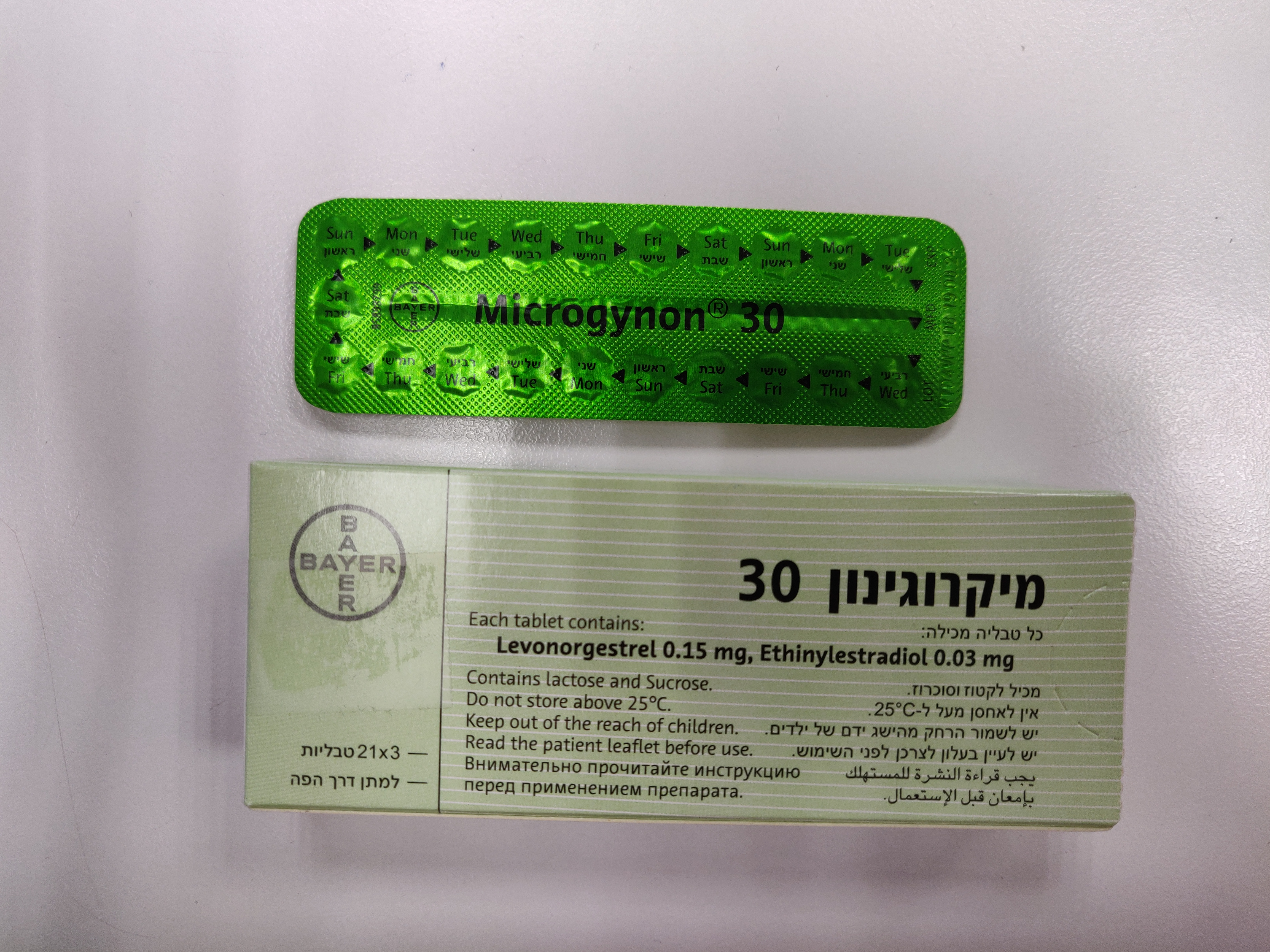Quest for the right Drug

מיקרוגינון 30 MICROGYNON ® 30 (ETHINYLESTRADIOL, LEVONORGESTREL)
תרופה במרשם
תרופה בסל
נרקוטיקה
ציטוטוקסיקה
צורת מתן:
פומי : PER OS
צורת מינון:
טבליות מצופות : COATED TABLETS
עלון לרופא
מינוניםPosology התוויות
Indications תופעות לוואי
Adverse reactions התוויות נגד
Contraindications אינטראקציות
Interactions מינון יתר
Overdose הריון/הנקה
Pregnancy & Lactation אוכלוסיות מיוחדות
Special populations תכונות פרמקולוגיות
Pharmacological properties מידע רוקחי
Pharmaceutical particulars אזהרת שימוש
Special Warning עלון לרופא
Physicians Leaflet
Pharmacological properties : תכונות פרמקולוגיות
Pharmacodynamic Properties
5.1 Pharmacodynamic properties Pharmacotherapeutic group: Sex hormones and modulators of the genital system, Progestogens and oestrogens, fixed combinations ATC Code: G03AA07 Microgynon 30 is an oestrogen-progestogen combination which acts by inhibiting ovulation by suppression of the mid-cycle surge of luteinising hormone, the inspissation of cervical mucus producing a barrier to sperm, and the rendering of the endometrium unreceptive to implantation.
Pharmacokinetic Properties
5.2 Pharmacokinetic properties Levonorgestrel Levonorgestrel is absorbed quickly and completely. Maximum active substance levels of approx 3 ng/ml were reached in serum just one hour after ingestion of Microgynon 30. The serum concentrations subsequently fell in 2 phases with half-lives of around 0.5 hours and 20 hours. The metabolic clearance rate from plasma is approx. 1.5 ml/min/kg. Levonorgestrel is eliminated not in unchanged form, but in the form of metabolites with a half-life of around one day and in almost equal proportions via the kidney and bile. Levonorgestrel is extensively metabolised. The major metabolites in plasma are the unconjugated and conjugated forms of 3α, 5β-tetrahydrolevonorgestrel. Based on in vitro and in vivo studies, CYP3A4 is the main enzyme involved in the metabolism of levonorgestrel. Levonorgestrel is bound to serum albumin and SHBG. Only around 1.5% of the respective total concentration is present in unbound form, while approx. 65% is bound to SHBG. The relative proportions (free, albumin-bound, SHBG-bound) depend on the concentration of SHBG. After induction of the binding protein, the portion bound to SHBG increases, while the free portion and that bound to albumin decreases. After daily repeated ingestion, levonorgestrel accumulates by about the factor 2. A steady state is reached during the second half of the treatment cycle. The pharmacokinetics of levonorgestrel are dependent on the concentration of SHBG in plasma. Under treatment with Microgynon, an increase in the levels of SHBG effect a concomitant increase in the specific binding capacity and therefore also an increase in levonorgestrel serum levels. The levonorgestrel serum levels do not change any further after 1 - 3 cycles of use owing to the fact that SHBG induction is concluded. Compared to a single administration, 3 - 4 fold higher levonorgestrel serum levels are reached in the steady state. The absolute bioavailability of levonorgestrel amounts to almost 100%. Approx. 0.1% of the maternal dose can be passed on to a baby with the breast milk. Ethinylestradiol Orally administered ethinylestradiol is absorbed quickly and completely. Ingestion of Microgynon 30 leads to maximum plasma levels of approx. 100 pg/ml after 1 - 2 hours. The substance concentration then falls in 2 phases for which half-lives of around 1 - 2 hours and about 20 hours have been determined. For technical reasons, these data can only be calculated at higher dosages. An imaginary distribution volume of around 5 l/kg and a metabolic clearance rate from plasma of approx. 5 ml/min/kg have been determined for ethinylestradiol. Ethinylestradiol is bound non-specifically to serum albumin to the extent of 98%. Ethinylestradiol is metabolised even during its absorption phase and during its first liver transit, leading to reduced and individually varying oral bioavailability. Ethinylestradiol is eliminated not in unchanged form, but in the form of metabolites with a half-life of around one day. The excretion ratio is 40 (urine) : 60 (bile). Because of the half-life of the terminal elimination phase from plasma, a steady state characterised by a 30 - 40% higher plasma substance level becomes established after approx. 5 - 6 daily administrations. The absolute bioavailability of ethinylestradiol is subject to considerable interindividual variations. After oral ingestion, it amounts to around 40 - 60% of the dose. In women with fully established lactation, around 0.02% of the maternal dose can be passed on to the baby with the breast milk. Other drugs can have a negative or positive effect on the systemic availability of ethinylestradiol. No interaction with vitamin C takes place. On continuous use, ethinylestradiol induces the hepatic synthesis of CBG and SHBG, the extent of SHBG induction being dependent on the type and dose of the simultaneously administered progestogen.

שימוש לפי פנקס קופ''ח כללית 1994
Contraception
תאריך הכללה מקורי בסל
01/01/1995
הגבלות
תרופה שאושרה לשימוש כללי בקופ'ח
מידע נוסף
עלון מידע לצרכן
18.01.16 - עלון לצרכן 09.03.22 - עלון לצרכן אנגלית 09.03.22 - עלון לצרכן עברית 09.03.22 - עלון לצרכן ערבית 11.10.22 - עלון לצרכן עברית 11.06.23 - עלון לצרכן 06.03.23 - עלון לצרכן אנגלית 06.03.23 - עלון לצרכן ערבית 30.08.23 - עלון לצרכן אנגלית 30.08.23 - עלון לצרכן עברית 30.08.23 - עלון לצרכן ערבית 14.11.19 - החמרה לעלון 13.09.20 - החמרה לעלון 24.06.21 - החמרה לעלון 11.10.22 - החמרה לעלון 11.06.23 - החמרה לעלוןלתרופה במאגר משרד הבריאות
מיקרוגינון 30